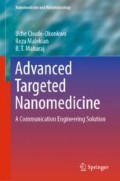Abstract
The development and deployment of ATN solutions require relentless interdisciplinary efforts in order to bring the system and its tremendous promises to reality. The level of the interdisciplinary commitment can encompass diverse fields such as nanotechnology, communication engineering, electronics, medical biology, systems biology, computational biology, synthetic biology, genetic engineering, molecular engineering, molecular/supramolecular chemistry, atomic/molecular physics, biophysics, bioelectronics, signal processing, information theory, advanced mathematics and translational science (Farokhzad and Langer in Adv Drug Deliv Rev 58:1456–1459, 2006, [1]). With this knowledge spread and planning, the design and development/fabrication of an ATN solution for a particular health challenge can be effectively achieved. It is therefore necessary to develop a framework that will serve as a guide for researchers through the design process and the steps in achieving the ATN goal. This exercise will eventually translate the ATN from the paper-based fundamental research, through the experimental stage to clinical reality.
Access this chapter
Tax calculation will be finalised at checkout
Purchases are for personal use only
References
Farokhzad OC, Langer R (2006) Nanomedicine: developing smarter therapeutic and diagnostic modalities. Adv Drug Deliv Rev 58:1456–1459
Chude-Okonkwo UAK, Malekian R, Maharaj BT (2016) Molecular communication model for targeted drug delivery in multiple disease sites with diversely expressed enzymes. IEEE Trans Nanobiosci 15(3):230–245
Alexis F, Pridgenm E, Molnar LK, Farokhzad OC (2008) Factors affecting the clearance and biodistribution of polymeric nanoparticles. Mol Pharm 5:505–515
Kowalczyk SW, Blosser TR, Dekker C (2011) Biomimetic nanopores: learning from and about nature. Trends Biotechnol 29:607–614
Adiga SP, Jin C, Curtiss LA, Monteiro-Riviere NA, Narayan RJ (2009) Nanoporous membranes for medical and biological applications. Wiley Interdisc Rev Nanomed Nanobiotechnol 1:568–581
Cormode DP, Naha PC, Fayad ZA (2014) Nanoparticle contrast agents for computed tomography: a focus on micelles. Contrast Media Mol Imaging 9:37–52
Anderson CE et al (2017) Dual contrast-magnetic resonance fingerprinting (DC-MRF): a platform for simultaneous quantification of multiple MRI contrast agents. Sci Rep 7(8431)
Han HS et al (2015) Quantum dot/antibody conjugates for in vivo cytometric imaging in mice. Proc Natl Acad Sci 112:1350–1355
Chude-Okonkwo UAK, Malekian R, Maharaj BT, Vasilakos AV (2017) Molecular communication and nanonetwork for targeted drug delivery: a survey. IEEE Commun Surv Tutorials 19:3046–3096
Ingalls B (2013) Mathematical modelling in systems biology: an introduction. MIT Press
Chude-Okonkwo UAK, Malekian R, Maharaj BT (2015) Diffusion-controlled interface kinetics-inclusive system-theoretic propagation models for molecular communication systems. EURASIP J Adv Signal Process 89:1–23
Chude-Okonkwo UAK (2014) Diffusion-controlled enzyme-catalyzed molecular communication system for targeted drug delivery. In: 2014 IEEE global communications conference, Austin, Texas, pp 2826–2831
Wolfram S (1984) Cellular automata as models of complexity. Nature 311:419–424
Ditlevsen S, Samson A (2013) Introduction to stochastic models in biology. In: Bachar M, Batzel JJ, Ditlevsen S (eds) Stochastic biomathematical models. Springer, pp 3–35
Meng TC, Somani S, Dhar P (2004) Modeling and simulation of biological systems with stochasticity. Silico Biol 4:293–309
Rangamani P, Iyengar R (2008) Modelling cellular signalling systems. Essays Biochem 45:83–94
Resat H, Costa MN, Shankaran H (2011) Spatial aspects in biological system simulations. Method Enzymol Elsevier 487:485–511
Elias J, Jarray A, Salazar J, Karmouch A, Mehaoua A (2013) A reliable design of wireless body area networks. In: IEEE global communications conference, pp 2742–2748
Aguirre E et al (2016) Design and performance analysis of wireless body area networks in complex indoor e-Health hospital environments for patient remote monitoring. Int J Distrib Sens Netw 12(9):1–17
Fatima M, Kiani AK, Baig A (2013) Medical body area network, architectural design and challenges: a survey. In: Shaikh FK, Chowdhry BS, Ammari HM, Uqaili MA, Shah A (eds) Wireless sensor networks for developing countries. Springer, pp 60–72
Yonzon CR, Stuart DA, Zhang X, McFarland AD, Haynes CL, Van Duyne RP (2005) Towards advanced chemical and biological nanosensors—an overview. Talanta 67:438–448
Felicetti L, Femminella M, Reali G, Liò P (2014) A molecular communication system in blood vessels for tumor detection. In: Proceedings of the first annual international conference on nanoscale computing and communication, p 21
Nakano T, Kobayashi S, Suda T, Okaie Y, Hiraoka Y, Haraguchi T (2014) Externally controllable molecular communication. IEEE J Sel Areas Commun 32:2417–2431
Chude-Okonkwo UAK, Malekian R, Maharaj BT (2016) Biologically inspired bio-cyber interface architecture and model for internet of bio-nanothings applications. IEEE Trans Commun 64:3444–3455
Zhang X, Sun C, Fang N (2004) Manufacturing at nanoscale: top-down, bottom-up and system engineering. J Nanopart Res 6:125–130
Akyildiz IF, Brunetti F, Blázquez C (2008) Nanonetworks: a new communication paradigm. Comput Netw 52:2260–2279
Meyer RA, Meyer RS, Green JJ (2015) An automated multidimensional thin film stretching device for the generation of anisotropic polymeric micro- and nanoparticles. J Biomed Mater Res Part A 103:2747–2757
Gong G et al (2011) Fabrication of a nanocarrier system through self-assembly of plasma protein and its tumor targeting. Nanotechnology 22(9):1–9
Chu KS et al (2014) Particle replication in nonwetting templates nanoparticles with tumor selective alkyl silyl ether docetaxel prodrug reduces toxicity. Nano Lett 14:1472–1476
Chi NT, Triet NM, Chien DM (2009) Preparation of drug nanoparticles by emulsion evaporation method. J Phys Conf Ser 187(1):1–5
Shah N, Sharma OP, Mehta T, Amin A (2016) Design of experiment approach for formulating multi-unit colon-targeted drug delivery system: in vitro and in vivo studies. Drug Dev Ind Pharm 42:825–835
Delalat B et al (2015) Targeted drug delivery using genetically engineered diatom biosilica. Nat Commun 6(8791):1–11
Robertson D, Williams GH (2009) Clinical and translational science: principles of human research. Academic Press, United Kingdom
Author information
Authors and Affiliations
Corresponding author
Rights and permissions
Copyright information
© 2019 Springer Nature Switzerland AG
About this chapter
Cite this chapter
Chude-Okonkwo, U., Malekian, R., Maharaj, B.T. (2019). Classical Framework for Case-Driven Design of Advanced Targeted Nanomedical Solution. In: Advanced Targeted Nanomedicine. Nanomedicine and Nanotoxicology. Springer, Cham. https://doi.org/10.1007/978-3-030-11003-1_5
Download citation
DOI: https://doi.org/10.1007/978-3-030-11003-1_5
Published:
Publisher Name: Springer, Cham
Print ISBN: 978-3-030-11002-4
Online ISBN: 978-3-030-11003-1
eBook Packages: Chemistry and Materials ScienceChemistry and Material Science (R0)

